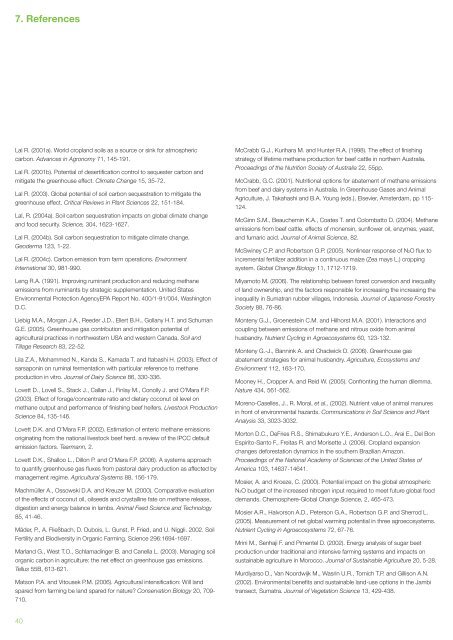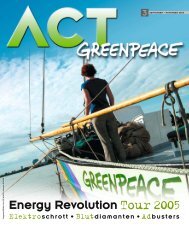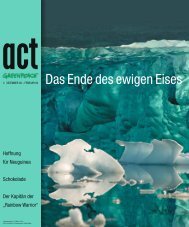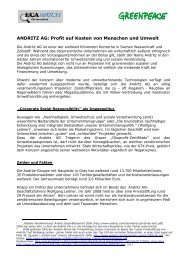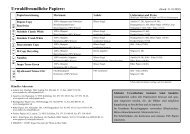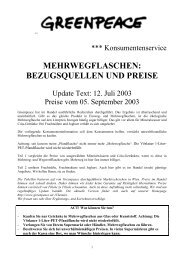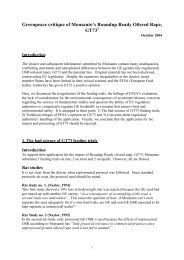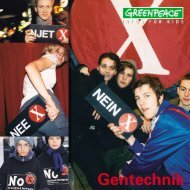Cool Farming: Climate impacts of agriculture and mitigation potential
Cool Farming: Climate impacts of agriculture and mitigation potential
Cool Farming: Climate impacts of agriculture and mitigation potential
Create successful ePaper yourself
Turn your PDF publications into a flip-book with our unique Google optimized e-Paper software.
7. References<br />
Lal R. (2001a). World cropl<strong>and</strong> soils as a source or sink for atmospheric<br />
carbon. Advances in Agronomy 71, 145-191.<br />
Lal R. (2001b). Potential <strong>of</strong> desertification control to sequester carbon <strong>and</strong><br />
mitigate the greenhouse effect. <strong>Climate</strong> Change 15, 35-72.<br />
Lal R. (2003). Global <strong>potential</strong> <strong>of</strong> soil carbon sequestration to mitigate the<br />
greenhouse effect. Critical Reviews in Plant Sciences 22, 151-184.<br />
Lal, R. (2004a). Soil carbon sequestration <strong>impacts</strong> on global climate change<br />
<strong>and</strong> food security. Science, 304, 1623-1627.<br />
Lal R. (2004b). Soil carbon sequestration to mitigate climate change.<br />
Geoderma 123, 1-22.<br />
Lal R. (2004c). Carbon emission from farm operations. Environment<br />
International 30, 981-990.<br />
Leng R.A. (1991). Improving ruminant production <strong>and</strong> reducing methane<br />
emissions from ruminants by strategic supplementation. United States<br />
Environmental Protection AgencyEPA Report No. 400/1-91/004, Washington<br />
D.C.<br />
Liebig M.A., Morgan J.A., Reeder J.D., Ellert B.H., Gollany H.T. <strong>and</strong> Schuman<br />
G.E. (2005). Greenhouse gas contribution <strong>and</strong> <strong>mitigation</strong> <strong>potential</strong> <strong>of</strong><br />
agricultural practices in northwestern USA <strong>and</strong> western Canada. Soil <strong>and</strong><br />
Tillage Research 83, 22-52.<br />
Lila Z.A., Mohammed N., K<strong>and</strong>a S., Kamada T. <strong>and</strong> Itabashi H. (2003). Effect <strong>of</strong><br />
sarsaponin on ruminal fermentation with particular reference to methane<br />
production in vitro. Journal <strong>of</strong> Dairy Science 86, 330-336.<br />
Lovett D., Lovell S., Stack J., Callan J., Finlay M., Conolly J. <strong>and</strong> O'Mara F.P.<br />
(2003). Effect <strong>of</strong> forage/concentrate ratio <strong>and</strong> dietary coconut oil level on<br />
methane output <strong>and</strong> performance <strong>of</strong> finishing beef heifers. Livestock Production<br />
Science 84, 135-146.<br />
Lovett D.K. <strong>and</strong> O’Mara F.P. (2002). Estimation <strong>of</strong> enteric methane emissions<br />
originating from the national livestock beef herd. a review <strong>of</strong> the IPCC default<br />
emission factors. Tearmann, 2.<br />
Lovett D.K., Shalloo L., Dillon P. <strong>and</strong> O'Mara F.P. (2006). A systems approach<br />
to quantify greenhouse gas fluxes from pastoral dairy production as affected by<br />
management regime. Agricultural Systems 88, 156-179.<br />
Machmüller A., Ossowski D.A. <strong>and</strong> Kreuzer M. (2000). Comparative evaluation<br />
<strong>of</strong> the effects <strong>of</strong> coconut oil, oilseeds <strong>and</strong> crystalline fate on methane release,<br />
digestion <strong>and</strong> energy balance in lambs. Animal Feed Science <strong>and</strong> Technology<br />
85, 41-46.<br />
Mäder, P., A. Fließbach, D. Dubois, L. Gunst, P. Fried, <strong>and</strong> U. Niggli. 2002. Soil<br />
Fertility <strong>and</strong> Biodiversity in Organic <strong>Farming</strong>. Science 296:1694-1697.<br />
Marl<strong>and</strong> G., West T.O., Schlamadinger B. <strong>and</strong> Canella L. (2003). Managing soil<br />
organic carbon in <strong>agriculture</strong>: the net effect on greenhouse gas emissions.<br />
Tellus 55B, 613-621.<br />
Matson P.A. <strong>and</strong> Vitousek P.M. (2006). Agricultural intensification: Will l<strong>and</strong><br />
spared from farming be l<strong>and</strong> spared for nature? Conservation Biology 20, 709-<br />
710.<br />
40<br />
McCrabb G.J., Kurihara M. <strong>and</strong> Hunter R.A. (1998). The effect <strong>of</strong> finishing<br />
strategy <strong>of</strong> lifetime methane production for beef cattle in northern Australia.<br />
Proceedings <strong>of</strong> the Nutrition Society <strong>of</strong> Australia 22, 55pp.<br />
McCrabb, G.C. (2001). Nutritional options for abatement <strong>of</strong> methane emissions<br />
from beef <strong>and</strong> dairy systems in Australia. In Greenhouse Gases <strong>and</strong> Animal<br />
Agriculture, J. Takahashi <strong>and</strong> B.A. Young (eds.), Elsevier, Amsterdam, pp 115-<br />
124.<br />
McGinn S.M., Beauchemin K.A., Coates T. <strong>and</strong> Colombatto D. (2004). Methane<br />
emissions from beef cattle. effects <strong>of</strong> monensin, sunflower oil, enzymes, yeast,<br />
<strong>and</strong> fumaric acid. Journal <strong>of</strong> Animal Science, 82.<br />
McSwiney C.P. <strong>and</strong> Robertson G.P. (2005). Nonlinear response <strong>of</strong> N2O flux to<br />
incremental fertilizer addition in a continuous maize (Zea mays L.) cropping<br />
system. Global Change Biology 11, 1712-1719.<br />
Miyamoto M. (2006). The relationship between forest conversion <strong>and</strong> inequality<br />
<strong>of</strong> l<strong>and</strong> ownership, <strong>and</strong> the factors responsible for increasing the increasing the<br />
inequality in Sumatran rubber villages, Indonesia. Journal <strong>of</strong> Japanese Forestry<br />
Society 88, 76-86.<br />
Monteny G.J., Groenestein C.M. <strong>and</strong> Hilhorst M.A. (2001). Interactions <strong>and</strong><br />
coupling between emissions <strong>of</strong> methane <strong>and</strong> nitrous oxide from animal<br />
husb<strong>and</strong>ry. Nutrient Cycling in Agroecosystems 60, 123-132.<br />
Monteny G.-J., Bannink A. <strong>and</strong> Chadwick D. (2006). Greenhouse gas<br />
abatement strategies for animal husb<strong>and</strong>ry. Agriculture, Ecosystems <strong>and</strong><br />
Environment 112, 163-170.<br />
Mooney H., Cropper A. <strong>and</strong> Reid W. (2005). Confronting the human dilemma.<br />
Nature 434, 561-562.<br />
Moreno-Caselles, J., R. Moral, et al., (2002). Nutrient value <strong>of</strong> animal manures<br />
in front <strong>of</strong> environmental hazards. Communications in Soil Science <strong>and</strong> Plant<br />
Analysis 33, 3023-3032.<br />
Morton D.C., DeFries R.S., Shimabukuro Y.E., Anderson L.O., Arai E., Del Bon<br />
Espirito-Santo F., Freitas R. <strong>and</strong> Morisette J. (2006). Cropl<strong>and</strong> expansion<br />
changes deforestation dynamics in the southern Brazilian Amazon.<br />
Proceedings <strong>of</strong> the National Academy <strong>of</strong> Sciences <strong>of</strong> the United States <strong>of</strong><br />
America 103, 14637-14641.<br />
Mosier, A. <strong>and</strong> Kroeze, C. (2000). Potential impact on the global atmospheric<br />
N2O budget <strong>of</strong> the increased nitrogen input required to meet future global food<br />
dem<strong>and</strong>s. Chemosphere-Global Change Science, 2, 465-473.<br />
Mosier A.R., Halvorson A.D., Peterson G.A., Robertson G.P. <strong>and</strong> Sherrod L.<br />
(2005). Measurement <strong>of</strong> net global warming <strong>potential</strong> in three agroecosystems.<br />
Nutrient Cycling in Agroecosystems 72, 67-76.<br />
Mrini M., Senhaji F. <strong>and</strong> Pimentel D. (2002). Energy analysis <strong>of</strong> sugar beet<br />
production under traditional <strong>and</strong> intensive farming systems <strong>and</strong> <strong>impacts</strong> on<br />
sustainable <strong>agriculture</strong> in Morocco. Journal <strong>of</strong> Sustainable Agriculture 20, 5-28.<br />
Murdiyarso D., Van Noordwijk M., Wasrin U.R., Tomich T.P. <strong>and</strong> Gillison A.N.<br />
(2002). Environmental benefits <strong>and</strong> sustainable l<strong>and</strong>-use options in the Jambi<br />
transect, Sumatra. Journal <strong>of</strong> Vegetation Science 13, 429-438.


